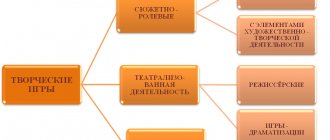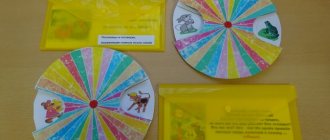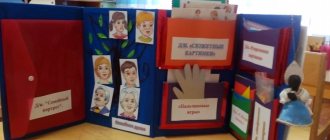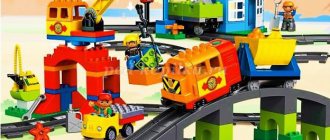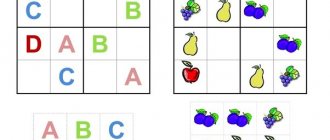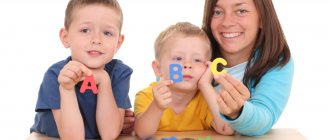Additional literature:
1. “Oral counting in horror stories and funny stories” by T. Rick.
I actually bought all the books of this author. (For the Russian language, I highly recommend her fairy tales)
2. “How to learn the multiplication table. And not only!"
I really liked the book, it has a lot of ideas not only for studying the multiplication tables, but also other school (and not only) information.
Firstly, with the help of this book you will be able to determine the leading type of memory of your child (and any adult) and choose the most suitable memorization methods for him.
Collection of samples of teaching aids for the sections of FEMP “Quantity and Counting”, “Quantities”
state budgetary professional educational institution
Rostov region
"Zernograd Pedagogical College"
Collection of samples of teaching aids for the sections of FEMP “Quantity and Counting”, “Quantities”
Zernograd 2022
Compiled by:
Angelina Ivanova, student 4 B group, specialty “Preschool Education”
Supervisor:
Oksana Aleksandrovna Globina, teacher of the professional cycle of the highest qualification category at the State Budgetary Educational Institution of Regional Educational Institution “ZernPK”.
The proposed collection is compiled in accordance with the Federal State Educational Standard for Secondary Professional Education in specialty 440201 “Preschool Education” and in accordance with the work program MDK 03.04. “Theory and Methods of Mathematical Development of Children” is intended for both individual and group activities of students specializing in “Preschool Education” in the educational process of the Zernograd Pedagogical College, as well as for educators, methodologists of preschool educational institutions and parents of preschool children.
This collection includes a number of samples of teaching aids on the sections of FEMP “Quantity and Counting”, “Quantities”, which contribute to the correct organization of direct educational activities of preschoolers in mathematical development.
TABLE OF CONTENTS
Introduction
Samples of teaching aids for the FEMP section “Quantity and Counting” in the junior group
Samples of teaching aids for the FEMP section “Quantity and Counting” in the middle group
Samples of teaching aids for the FEMP section “Quantity and Counting” in the senior group
Samples of teaching aids for the FEMP section “Quantity and Counting” in the preparatory group
Samples of teaching aids for the FEMP section “Magnitude” in the junior group
Samples of teaching aids for the FEMP “Value” section in the middle group
Samples of teaching aids for the FEMP “Magnitude” section in the senior group
Samples of teaching aids for the FEMP “Magnitude” section in the preparatory group
INTRODUCTION
The
mathematical development of preschoolers should be understood as shifts and changes in the cognitive activity of the individual that occur as a result of the formation of elementary mathematical concepts and related logical operations.
The formation of elementary mathematical concepts
is a purposeful and organized process of transferring and assimilating knowledge, techniques and methods of mental activity (in the field of mathematics).
Samples of teaching aids for the FEMP section “Quantity and Counting” in the junior group
Samples of teaching aids for the FEMP section “Quantity and Counting” in the middle group
Samples of teaching aids for the FEMP section “Quantity and Counting” in the senior group
Samples of teaching aids for the FEMP section “Quantity and Counting” in the preparatory group
Samples of teaching aids for the FEMP section “Magnitude” in the junior group
Samples of teaching aids for the FEMP “Value” section in the middle group
Samples of teaching aids for the FEMP “Magnitude” section in the senior group
Samples of teaching aids for the FEMP “Magnitude” section in the preparatory group
Literature
- Kozlova, S.A. Preschool pedagogy [Text]/ S.A. Kozlova, T.A. Kulikova. – M.: “ACADEMY”, 2015 with changes. – 432s.
- Freilakh, N.I. Methodology of mathematical development [Text]/ N.I. Freilach. – M.: Publishing House “FORUM”, 2014.- 240 p.
Entertaining books on mathematics for preschoolers
Lyudmila Vishnyakova
Entertaining books on mathematics for preschoolers
Slide 2
Mathematics is the “queen of sciences”
, she prefers accuracy, conciseness, specificity and abstraction.
Teaching a child to think, to find a way out of non-standard situations, not only mathematical ones , but also unwritten, life ones, is the task not only of the school and kindergarten, but first of all of the parents.
What is fun math ? Entertaining mathematics for preschoolers is an interesting and exciting activity. Mathematics for kids begins with familiarization with numerical quantities and numbers. This knowledge base is necessary for a child even before entering school. Therefore, help from parents is necessary specifically in elementary school and in the preschool period . Starting from an early age, children need to be interested in arithmetic as a science. After all, mathematics for the little ones begins at home. Preschoolers of this age must realize that objects can be counted and the number of objects can be called a number. Organization of mathematical activities of preschool children through the use of entertaining books , which can and should be used in classes with children in a family setting. Introducing this subject in a playful and entertaining way will help the child prepare for school faster and easier in the future.
Joint activities in the family to develop elementary mathematical concepts in a child bring the following positive results:
SLIDE 3
- awaken parents’ interest in the level of mental development of children and contribute to the development of logical thinking, memory, attention, and fine motor skills in children in accordance with their age and abilities;
— deepen the relationship between parents and children, unite the family, serve mutual enrichment;
- create in the family an atmosphere of mutual attention and business cooperation, which is so necessary for solving any educational problems;
- allow the free time that the mother or father devotes to the child to be spent usefully;
– contribute to the comprehensive development of the child (persistence in achieving goals, perseverance)
and are beneficial for the child’s mental state;
Entertaining mathematics for preschoolers
The formation of “scientific thinking” begins to take shape from the earliest stages of a child’s development. From the cradle, we let children feel objects of different textures, shapes and colors, doing the simplest massage, counting fingers, telling fairy tales, reading books.
Many of these fairy tales and books actually contain a lot of real mathematical information .
Slide 4
The most trivial example of a “ mathematical ” fairy tale is, of course, “The Turnip.” With the help of this fairy tale, for example, such an important idea from mat is formed. analysis, as “an increase in the infinitesimal,” or, say, the philosophical concept of “the transition of quantity into quality.” They also remind me of the fairy tale about the Three Bears, and in general, I must say that the numbers 3, 4 and 7 in fairy tales are very, very popular!
Among the author's fairy tales there are those in which much attention is paid to mathematical concepts :
Slide 5
The book “The Adventures of Treugoshi: A mathematical fairy tale for children from 2 to 4 years old”
Three-year-old boy Misha invents and draws a fairy-tale hero - Treugosh. Treugosha goes on a journey, during which various funny stories happen to him.
Children from 2 to 4 years old, listening to a fairy tale, looking at illustrations and answering questions, master basic mathematical knowledge , which will be useful to them in preparing for school.
SLIDE 6
In the book “Juventik in the land of numbers and figures” for children from 4 to 7 years old
This book presents entertaining tasks that develop spatial imagination and logical thinking preschoolers Kids solve examples and problems, perform graphic dictations, complete missing parts of objects, establish cause-and-effect, logical connections and patterns.
The main goal of the book is to develop a preschooler's interest in mathematics .
Slide 7
The pearl among mathematical books for the little ones is, of course, the famous series about Kubarik and Tomatik - books one and two .
An interesting fairy tale that will make it easier for a child to learn simple mathematical operations , such as “more”, “less”, “equal”, “circle”, “square”, etc. Bright color pictures will not only interest the child, but will also give a positive result in learning .
The book is a preparatory stage of the author’s educational program “ Mathematics for Preschoolers ”.
Slide 8
Georgy Yudin’s book “ Entertaining ”: “ Entertaining mathematics for girls and boys 4-7 years old. " Zanimatika " is the cheerful little sister of arithmetic. It will help children not only quickly memorize numbers and solve simple problems with them, but will also give them their first understanding of the theory of relativity, space, time and, most importantly, teach them to think creatively and find the right solutions both in arithmetic and in life. » Fun educational tasks will help your child develop motor skills, imagination, lateral thinking, logic, counting and attention. The tasks are compiled taking into account the age characteristics of children and are structured according to the principle from simple to complex.
For children 6-7 years old, tasks are presented: cross out the extra, solve examples, show the necessary figures, find the shadow of the figure, cross out the extra number, write counting in twos, threes, tasks for understanding time, tasks for spatial imagination, color so that they are not the same, continue the row, counting from 10 to 20.
Slide 9
Books will also be useful for parents to teach their children a preschooler’s life . Each age has its own color, its own gnome, its own books . For example, all books for children aged 1-2 years have blue covers. Seven years before school - seven colors of the rainbow. The manuals have been developed in accordance with modern educational standards and will be useful to both parents and specialists: educators, methodologists. The set includes the books : “Whose voice is this?”, “Color. Shape”, “Big, small”, “Plasticine snowball”, “Cheerful, sad”, “My house”, “Finger painting”, “In the village and in the country”, “Walking around the city”, “Whose tail is this?” , “My first dictionary”, “Who is this, what is this?”.
The manuals are developed in accordance with modern educational standards.
Slide 10
Based on the book Irina Vladimirovna Maltseva MATHEMATICS FOR PRESCHOOL CHILDREN FROM A TO Z
You can teach your child quickly and with pleasure: count within 10, compare sets, reason logically, analyze, add and subtract, solve problems, explore the world.
Slide 11
“Together we learn to count. Entertaining mathematics for preschoolers . Workbook No. 2. Federal State Educational Standard"
Fun math workbooks will help kids learn basic math in a fun way. Together with the game characters Ryzhik the fox and Fluffy the bunny, children will become familiar with numbers, remember their sequence, learn to count to ten, and compare objects by size and shape.
The manual promotes the development of visual perception, voluntary attention, the formation of the first skills of analysis and comparison, and the improvement of fine motor skills.
Slide 12
Entertaining mathematics for preschoolers should form children's first mathematical knowledge , consolidate the skills of quantitative and ordinal counting, and first calculations using addition and subtraction operations.
Fun math should last no more than 15 minutes a day. You can learn to count not only at your desk, but also in the yard, counting, for example, children on the playground and steps in the entrance, and even at lunch, arranging pieces of potatoes in a bowl of soup.

